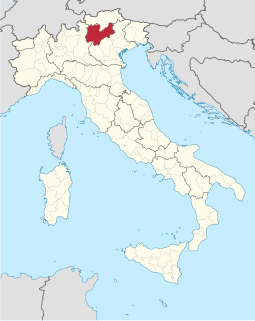The Euganei (fr. Lat. Euganei, Euganeorum; cf. Gr. εὐγενής (eugenēs) 'well-born') were a semi-mythical Proto-Italic ethnic group that dwelt an area among Adriatic Sea and Rhaetian Alps. Subsequently, they were driven by the Adriatic Veneti to an area between the river Adige and Lake Como, where they remained until the early Roman Empire. [1]

Latin is a classical language belonging to the Italic branch of the Indo-European languages. The Latin alphabet is derived from the Etruscan and Greek alphabets and ultimately from the Phoenician alphabet.

Greek is an independent branch of the Indo-European family of languages, native to Greece, Cyprus and other parts of the Eastern Mediterranean and the Black Sea. It has the longest documented history of any living Indo-European language, spanning more than 3000 years of written records. Its writing system has been the Greek alphabet for the major part of its history; other systems, such as Linear B and the Cypriot syllabary, were used previously. The alphabet arose from the Phoenician script and was in turn the basis of the Latin, Cyrillic, Armenian, Coptic, Gothic, and many other writing systems.

The Proto-Italic language is the ancestor of the Italic languages, including notably Latin and thus its descendants, the Romance languages. It is not directly attested in writing, but has been reconstructed to some degree through the comparative method. Proto-Italic descended from the earlier Proto-Indo-European language.
Contents
They may have been a Pre-Indo-European people, ethnically related to the Ingauni, as suggested by the similarity of the names. According to Pliny the Elder the Stoni people from Trentino were of the same stock as the Euganei.

Neolithic Europe is the period when Neolithic technology was present in Europe, roughly between 7000 BCE and c. 1700 BCE. The Neolithic overlaps the Mesolithic and Bronze Age periods in Europe as cultural changes moved from the southeast to northwest at about 1 km/year - this is called Neolithic Expansion.

Pliny the Elder was a Roman author, naturalist and natural philosopher, a naval and army commander of the early Roman Empire, and friend of emperor Vespasian.

Trentino, officially the Autonomous Province of Trento, is an autonomous province of Italy, in the country's far north. Trento and South Tyrol constitute the region of Trentino-Alto Adige/Südtirol, an autonomous region under the constitution. The province is divided into 177 comuni (municipalities). Its capital is the city of Trento. The province covers an area of more than 6,000 km2 (2,300 sq mi), with a total population of about 540,000. Trentino is renowned for its mountains, such as the Dolomites, which are part of the Alps.
Cato the Elder, in the lost book of Origines, counted among the major tribes of the Euganeans; the Triumplini of Val Trompia and the Camunni of Val Camonica. [2]

Cato the Elder, born Marcus Porcius Cato and also known as Cato the Censor, Cato the Wise, and Cato the Ancient, was a Roman senator and historian known for his conservatism and opposition to Hellenization. He was the first to write history in Latin.
The Val Trompia is a slightly more than 50 km long valley in the Province of Brescia, northern Italy. It consists of the valleys of the river Mella and its tributaries, north of the city of Brescia. It is situated between Val Camonica, Val Sabbia and Lake Iseo.

The Camuni or Camunni were an ancient population located in Val Camonica during the Iron Age ; the Latin name Camunni was attributed to them by the authors of the 1st century. They are also called ancient Camuni, to distinguish them from the current inhabitants of the valley. The Camunni were among the greatest producers of rock art in Europe; their name is linked to the famous rock engravings of Valcamonica.
According to Livy, they were defeated by the Adriatic Veneti and the Trojans. Their descendants settled west of the Athesis (Adige) river, around the lakes Sebinus, Edrus and Benacus, where they occupied 34 towns, which were admitted by Augustus to the rights of Latin municipalities.

Titus Livius – simply rendered as Livy in English – was a Roman historian. He wrote a monumental history of Rome and the Roman people – Ab Urbe Condita Libri – covering the period from the earliest legends of Rome before the traditional foundation in 753 BC through the reign of Augustus in Livy's own lifetime. He was on familiar terms with members of the Julio-Claudian dynasty and even in friendship with Augustus, whose young grandnephew, the future emperor Claudius, he exhorted to take up the writing of history.

The Veneti were an Indo-European people who inhabited northeastern Italy, in an area corresponding to the modern-day region of Veneto.

Troy was a city in the far northwest of the region known in late Classical antiquity as Asia Minor, now known as Anatolia in modern Turkey, just south of the southwest mouth of the Dardanelles strait and northwest of Mount Ida. The present-day location is known as Hisarlik. It was the setting of the Trojan War described in the Greek Epic Cycle, in particular in the Iliad, one of the two epic poems attributed to Homer. Metrical evidence from the Iliad and the Odyssey suggests that the name Ἴλιον (Ilion) formerly began with a digamma: Ϝίλιον (Wilion); this is also supported by the Hittite name for what is thought to be the same city, Wilusa.








